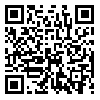Volume 25, Issue 2 (2022)
mjms 2022, 25(2): 47-54 |
Back to browse issues page
Ethics code: IR.MODARES.REC.1399.088
Download citation:
BibTeX | RIS | EndNote | Medlars | ProCite | Reference Manager | RefWorks
Send citation to:



BibTeX | RIS | EndNote | Medlars | ProCite | Reference Manager | RefWorks
Send citation to:
Zarei P, Shojaei A, Fathollahi Y, Raoufy M R, Mirnajafi-Zadeh J. Effect of High- and low-frequency stimulation of olfactory bulb on open field activity monitoring indices in kindled rats. mjms 2022; 25 (2) :47-54
URL: http://mjms.modares.ac.ir/article-30-73199-en.html
URL: http://mjms.modares.ac.ir/article-30-73199-en.html
Parisa Zarei1 
 , Amir Shojaei1
, Amir Shojaei1 
 , Yaghoub Fathollahi1
, Yaghoub Fathollahi1  , Mohammad Reza Raoufy1
, Mohammad Reza Raoufy1  , Javad Mirnajafi-Zadeh
, Javad Mirnajafi-Zadeh 
 2
2

 , Amir Shojaei1
, Amir Shojaei1 
 , Yaghoub Fathollahi1
, Yaghoub Fathollahi1  , Mohammad Reza Raoufy1
, Mohammad Reza Raoufy1  , Javad Mirnajafi-Zadeh
, Javad Mirnajafi-Zadeh 
 2
2
1- Department of Physiology, Faculty of Medical Sciences, Tarbiat Modares University, Tehran, Iran
2- Department of Physiology, Faculty of Medical Sciences, Tarbiast Modates University, Tehran, Iran , mirnajaf@modares.ac.ir
2- Department of Physiology, Faculty of Medical Sciences, Tarbiast Modates University, Tehran, Iran , mirnajaf@modares.ac.ir
Abstract: (7 Views)
Deep brain stimulation (DBS) stands as an alternative treatment for drug-resistant temporal lobe epilepsies. In this study, we investigated the effects of both low- and high-frequency stimulation (LFS and HFS) of the olfactory bulb on locomotor activity and preferences for spending time in the central or border regions. Rats underwent a kindling procedure involving semi-rapid electrical stimulation (6 stimulations per day) of the hippocampal CA1 region. Fully kindled animals received LFS (1 Hz) or HFS (130 Hz) at four time points: 5 min, 6 h, 24 h, and 30 h after the last kindling stimulation. Subsequently, rats were placed in the open field chamber and allowed free, uninterrupted movement within the respective quadrant of the maze for a single 10-minute period. During this time, tracking software recorded movement, and locomotor activity as well as preferences for spending time in the central or border regions were evaluated. Overall, applying DBS in the olfactory bulb at both low and high frequencies decreased exploration time in the center and increased exploration time in the border for the rats. Furthermore, a higher intensity of HFS was more effective than a lower intensity of HFS in reducing anxiety or altering locomotor behavior. According to the results of the present study it may be suggested that applying DBS affects some aspects of the animals’ activity and therefore, the activity monitoring tests have to be done following DBS application.
Send email to the article author
| Rights and permissions | |
 |
This work is licensed under a Creative Commons Attribution-NonCommercial 4.0 International License. |





